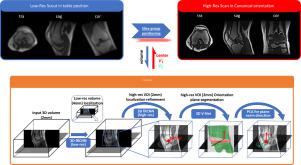Medical Image Analysis ( IF 10.9 ) Pub Date : 2022-07-06 , DOI: 10.1016/j.media.2022.102529 Yu Zhao 1 , Ke Zeng 1 , Yiyuan Zhao 1 , Parmeet Bhatia 1 , Mahesh Ranganath 1 , Muhammed Labeeb Kozhikkavil 2 , Chen Li 3 , Gerardo Hermosillo 1

|
Magnetic Resonance (MR) imaging plays an important role in medical diagnosis and biomedical research. Due to the high in-slice resolution and low through-slice resolution nature of MR imaging, the usefulness of the reconstruction highly depends on the positioning of the slice group. Traditional clinical workflow relies on time-consuming manual adjustment that cannot be easily reproduced. Automation of this task can therefore bring important benefits in terms of accuracy, speed and reproducibility. Current auto-slice-positioning methods rely on automatically detected landmarks to derive the positioning, and previous studies suggest that a large, redundant set of landmarks are required to achieve robust results. However, a costly data curation procedure is needed to generate training labels for those landmarks, and the results can still be highly sensitive to landmark detection errors. More importantly, a set of anatomical landmark locations are not naturally produced during the standard clinical workflow, which makes online learning impossible. To address these limitations, we propose a novel framework for auto-slice-positioning that focuses on localizing the canonical planes within a 3D volume. The proposed framework consists of two major steps. A multi-resolution region proposal network is first used to extract a volume-of-interest, after which a V-net-like segmentation network is applied to segment the orientation planes. Importantly, our algorithm also includes a Performance Measurement Index as an indication of the algorithm’s confidence. We evaluate the proposed framework on both knee and shoulder MR scans. Our method outperforms state-of-the-art automatic positioning algorithms in terms of accuracy and robustness.
中文翻译:

医学图像定位和方向检测的深度学习解决方案
磁共振 (MR) 成像在医学诊断和生物医学研究中发挥着重要作用。由于 MR 成像的高切片分辨率和低切片分辨率特性,重建的有用性在很大程度上取决于切片组的定位。传统的临床工作流程依赖于耗时且不易复制的手动调整。因此,这项任务的自动化可以在准确性、速度和可重复性方面带来重要的好处。当前的自动切片定位方法依赖于自动检测到的地标来推导定位,之前的研究表明需要大量冗余的地标集才能获得稳健的结果。然而,需要昂贵的数据管理程序来为这些地标生成训练标签,结果仍然对地标检测错误高度敏感。更重要的是,在标准的临床工作流程中并没有自然产生一组解剖标志位置,这使得在线学习变得不可能。为了解决这些限制,我们提出了一个新的自动切片定位框架,该框架专注于在 3D 体积内定位规范平面。拟议的框架包括两个主要步骤。首先使用多分辨率区域建议网络提取感兴趣体积,然后应用类似 V-net 的分割网络来分割方向平面。重要的是,我们的算法还包括一个性能衡量指标,作为算法置信度的指示。我们评估了膝关节和肩部 MR 扫描的拟议框架。



























 京公网安备 11010802027423号
京公网安备 11010802027423号